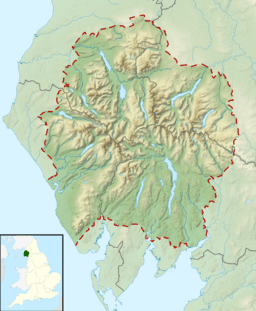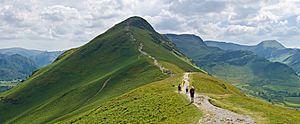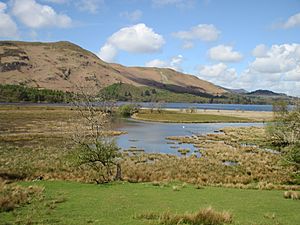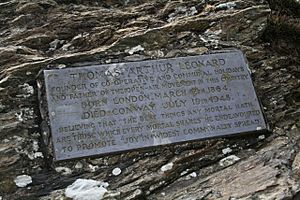Cat Bells facts for kids
Quick facts for kids Cat Bells |
|
|---|---|
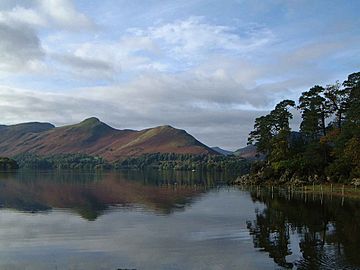
The classic view of Cat Bells from near Friars' Crag on the opposite side of Derwentwater
|
|
| Highest point | |
| Elevation | 451 m (1,480 ft) |
| Prominence | 86 m (282 ft) |
| Parent peak | Dale Head |
| Listing | Wainwright |
| Geography | |
| Location | Cumbria, England |
| Parent range | Lake District, North Western Fells |
| OS grid | NY244199 |
| Topo map | OS Landrangers 89, 90, Explorer OL4 |
Cat Bells is a famous small mountain, called a "fell," located in the beautiful Lake District in Cumbria, England. It stands about 451 meters (1,480 feet) tall. This makes it one of the most popular fells in the area.
Cat Bells is found on the western side of Derwentwater lake. It is only about 5 kilometers (3 miles) from the busy town of Keswick. Its unique shape catches the eye of many visitors. People often feel they must climb to its top. This is especially true after seeing it from Friars' Crag across the lake.
A famous Lake District writer, Alfred Wainwright, loved Cat Bells. He said it was a "family fell." This means grandmothers and children can climb it together. He also said its popularity is well-deserved. Its shape looks inviting, offering a steep but simple climb.
Contents
What's in a Name?
The Meaning Behind "Cat Bells"
The unusual name of this fell might come from "Cat Bields." This old term means "shelter of the wild cat." However, no one is completely sure about this. Sometimes, you might see the name written as Catbells.
Exploring the Mountain's Shape
How Cat Bells Looks from Different Sides
Cat Bells is the last fell on a ridge of mountains. This ridge separates Derwentwater lake from the Newlands valley. It rises straight south from a place called Hawse End. The climb to the top happens in two clear steps. The lower part of the mountain is named Skelgill Bank.
After the very top of Cat Bells, the land dips down steeply. This dip is called Hause Gate. Beyond this, the ridge gets wider. It then turns southwest towards another fell, Maiden Moor.
Climbing Cat Bells
Popular Routes to the Summit
Most people start their climb of Cat Bells from Hawse End. This is at the bottom of the northern ridge. There is a car park here. But it fills up quickly on busy summer days. You can also start climbing from Grange or from Newlands.
Hawse End is also a stop for the Derwentwater Motor Launch boat. This means visitors from Keswick can enjoy a boat ride. Then they can get off and climb the fell. Many climbers reach the top, enjoy the view, and then go back down the same way.
However, strong walkers can keep going along the ridge. They can visit other fells like Maiden Moor, High Spy, and Dale Head. This longer walk is known as a "horseshoe walk." It ends back in the Newlands valley, near Hawse End.
Views from the Top
What You Can See from Cat Bells' Summit
The very top of Cat Bells is rocky. There are many loose stones among small rock outcrops. The view from the summit is amazing. You get a fantastic bird's-eye view of Derwentwater lake.
To the north, you can clearly see Bassenthwaite Lake, the Newlands Valley, Skiddaw, and Keswick. Looking south, there is a beautiful view of Borrowdale.
Old Mines on the Mountain
A Look at Cat Bells' Mining History
Even though Cat Bells is known as a "family fell," it does have some old dangers. These come from the disused lead mines on its slopes. The Yewthwaite mine is on the western side of the fell. It has large piles of waste rock and old mine shafts. Many of these shafts used to be open and dangerous. But most of them have now been safely blocked off.
The Brandlehow and Old Brandley Mines were on the Derwentwater (eastern) side. They dug for lead ore. All three mines stopped working in the 1890s.
Cat Bells in Books
Famous Writers and the Fell
- On the lower slopes of Cat Bells, above Derwentwater, is Brackenburn Lodge. This is now a holiday home. But it used to be the home of Hugh Walpole. He wrote his famous Herries series of books here. He lived there from 1924 until he passed away in 1941. He called it "a little paradise on Cat Bells."
- The famous children's author Beatrix Potter also featured Cat Bells. She placed the home of her character Mrs. Tiggy-Winkle on the eastern slopes of the fell.
Remembering Important People
Memorials on Cat Bells
On the lower slopes of the fell, there is a special stone. It is a memorial to Thomas Arthur Leonard (1864-1948). He was a pioneer who helped create outdoor holidays for working people. He started groups like the Co-operative Holidays Association and the Holiday Fellowship.


